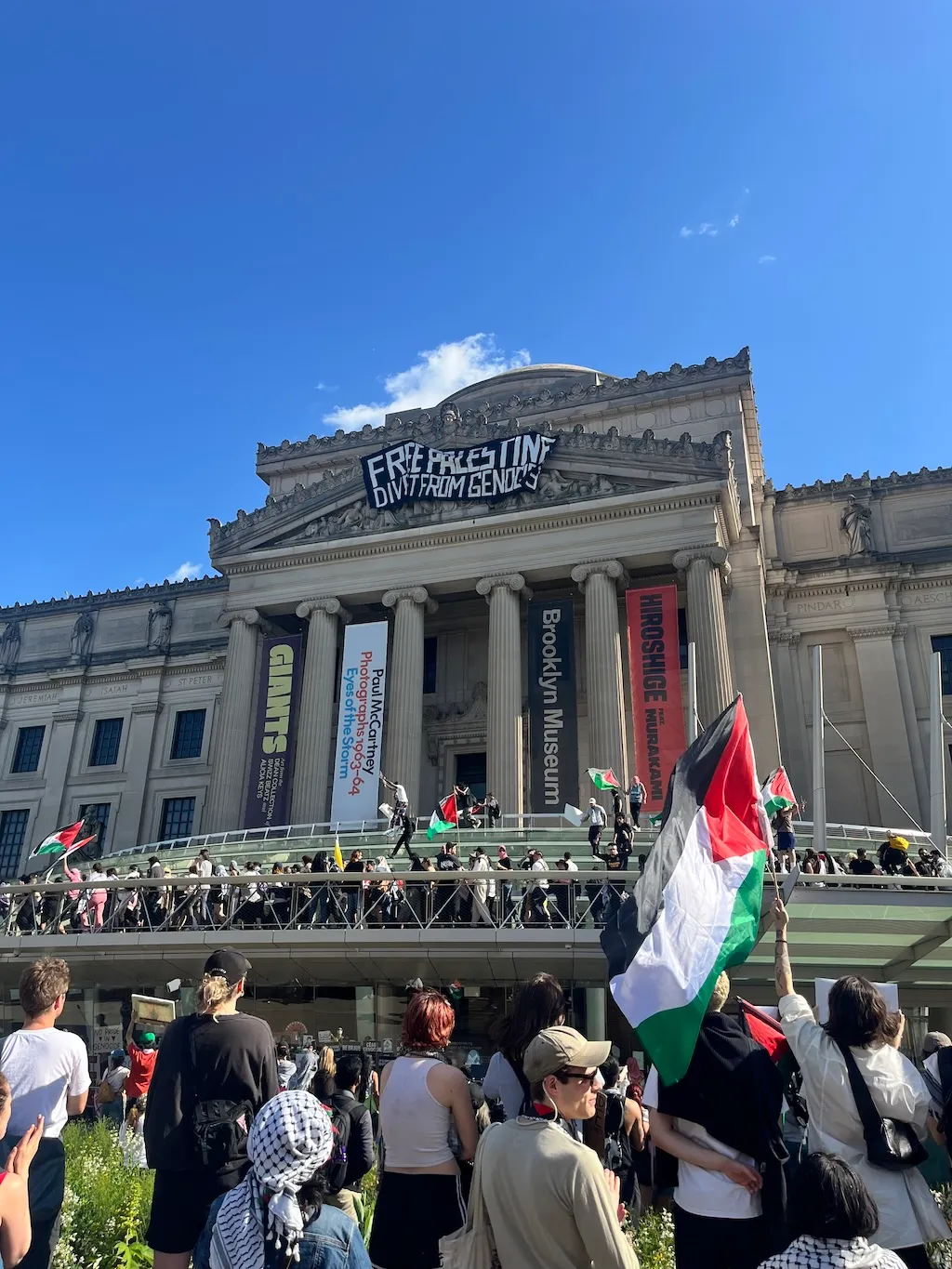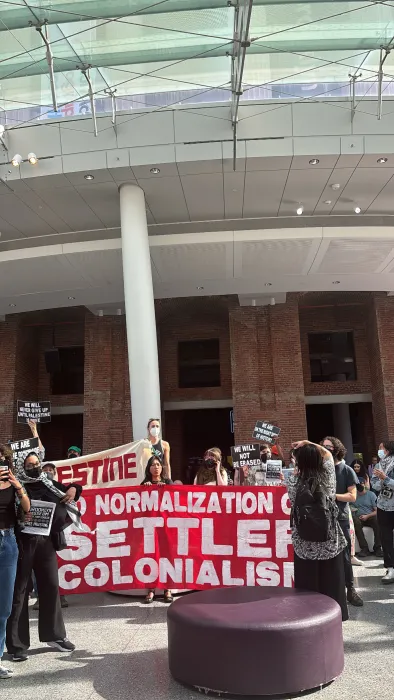
As afternoon dimmed into evening Friday, the Brooklyn Museum became the stage of one the most fervent Gaza solidarity actions yet to descend on a New York City art institution.
Starting at 4:30 p.m. inside the lobby, a group of cultural workers, artists, and New York City community members brandished banners, beat drums, and blew whistles, calling for the museum to condemn the killing of Palestinians in Gaza, as well as disclose and divest its financial ties to Israel.
Outside the museum, a hundreds-strong march that began in downtown Brooklyn ended at its glass facade. Barred from entering the museum, some protestors plastered posters to the doors; others climbed the steps to its exterior mezzanine and upward its glass ceiling, finally unfurling a banner across the museum’s neoclassical cornice that read “Free Palestine From Genocide”.
Police followed the protestors to the roof, while a helicopter circled overhead.

In a statement provided to press ahead of the protest by Cultural Front for Free Palestine, the newly formed advocacy coalition decried the lack of public statements from major art institutions on Israel’s seven-month long military campaign in Gaza, which has—as of publication—resulted in the death of more than 30,000 Palestinians, according to the local health ministry. The statement paid particular attention to Israel’s ongoing offensive of the southern Gaza city of Rafah, where some one million Palestinian had been seeking refuge. (Most have since fled amid the assault, the New York Times and the UN reported earlier this week.)
The statement calls for the museum to publicly recognize the war in Gaza as a genocide, citing evidence put forth by human rights entities such as the International Federation for Human Rights and the UN Special Rapporteur. The Cultural Front said it is also demanding a full disclosure of investments linked to companies that “profit from the arming of Israel” and a subsequent divestment from corporations linked to Israel, in addition to “all arms and surveillance manufacturers.”
“The Museum relies heavily on subsidies from the City of New York, along with the granting of the land it sits on, and so its financial doings should be publicly accountable. That process of accountability should also involve the disclosure of funds from donors and trustees who are heavily implicated in the Occupation,” the statement added.
The Brooklyn Museum has previously been targeted by pro-Palestine demonstrations. On December 8, around 20 protestors affiliated with the activist groups Decolonize This Place and Within Our Lifetime staged a guerilla action inside the lobby, echoing the calls of similar demonstrations to “disclose and divest.” The next day, hundreds of protestors gathered at the museum as the starting point of a planned march that swept across the Brooklyn Bridge and ended at City Hall. Both protests called out the museum’s corporate partnership with Bank of New York Melllon, which has investments in Israeli weapons manufacturer Elbit Systems and has supported the Friends of Israel Defense Force Donor Advised Fund. (The Bank told FT in April that it invests in Elbit “as a result of requirements by its passive index investment strategies.”)
Pro-Palestine protestors have also demonstrated at the Museum of Modern Art, the Whitney Museum, and the Metropolitan Museum of Art. Famous art schools, such as Cooper Union in New York and the Rhode Island School of Design, have experienced occupations and walkouts by students, faculty, and alumni dissatisfied with a presumed apathy to the war in Gaza.
“People are assembling in the spirit of reparation and care for communities conquered and looted by colonialism,” the Cultural Front said. “These include far-flung places and neighborhoods just a stone’s throw from here. Land, wealth, and culture are among the historical plunder, and institutions like the Brooklyn Museum are a direct beneficiary.”
On Friday at the Brooklyn Museum, police and museum security staff dispelled protestors inside the museum lobby—no protestors entered the galleries—around 5:20 p.m. By then, the floor was scattered with synthetic red poppy petals, which has been adopted as a symbol of resistance by protestors due to the flower’s indigeneity to Palestine. The protestors, holding banners that read among other slogans, “Silence = Death,” remained peaceful. Several tents had been erected in the lobby by protestors intending to transition into an overnight occupation.
By 6 p.m. protestors had gradually moved away from the museum entrance — and descended from the atrium roof— though a crowd remained outside. Clad in keffiyehs and waving the Palestinian flag, a group scrawled slogans across Deborah Kass’OY/YO installation: “Fuck Bullshit Museum” and “NYPD KKK”; arrests were eventually made. Police began removing the banner from the museum (with apparent difficulty) to a chorus of boos.
The Brooklyn Museum did not respond to a request for comment by the time of publication.
